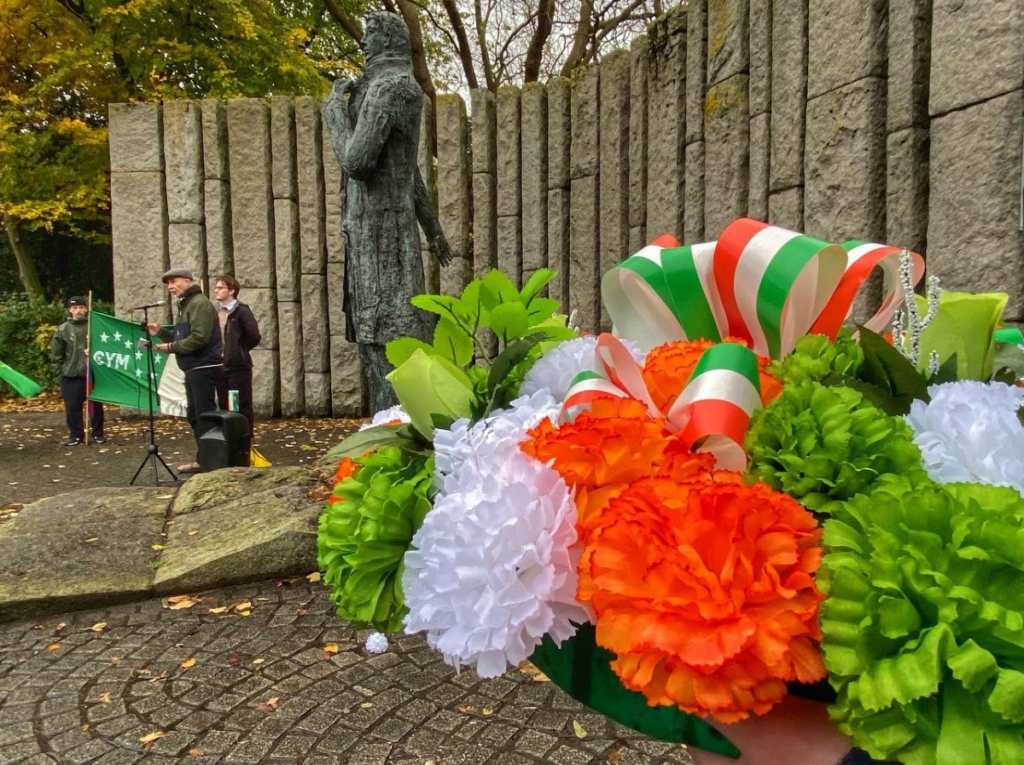On 26th November 2022 the Connolly Youth Movement held a commemoration for the 109th anniversary of the Irish Citizen Army. The Irish Citizen Army had made its first debut on the 23rd November 1913 at Fairview Park, and remains a cornerstone of Irish socialist and working-class history, and their vision of an Irish Socialist Republic remains the ambition of the CYM.
The commemoration took place at the Wolfe Tone statue at St. Stephen’s Green, both to honour the Republican ideals which the Citizen Army fought for, but also the significance of the Green itself. It was at that spot in 1916 that the ICA dug trenches, before being forced to fall back by British machine-gun fire from the Shelbourne Hotel.
The Connolly Youth Movement would like to thank the Diarmuid Breatnach for performing James Connolly’s “Be Moderate” and talking about the life of Constance Markievicz and threats to the history and legacy of the Irish Citizen Army and republicanism posed by developers and an uncaring government, as well as the representative from the Independent Workers Union for talking about the ongoing relevance of the trade union struggle. We would also like to thank Lasair Dhearg, the Independent Workers Union, Irish Communist Party and Welsh Socialist Republican Solidarity (WUN Ireland) for laying wreaths, alongside the dozens of attendees who came to pay their respects.
Transcript of the CYM speech below:
“A chairde agus comraidithe,
We are gathered here today to mark the 109th anniversary of the Irish Citizen Army, which made its public debut on the 23rd November 1913.
The Citizen Army was a direct response to the brutality carried out by the RIC and DMP during the Dublin Lockout; the police had killed two workers, injured hundreds more with baton charges, and frequently ransacked the tenements where strikers lived. The Citizen Army fought back with some success, as one pointed out, a hurley has a longer reach than a baton. It was in the Citizen Army that the working-class stood up to the RIC and employers; the same RIC which had torched farmer’s homes during the land-war and the same employers who often owned the slums where workers lived, and it was here at Stephen’s Green (and elsewhere in the city) that the Citizen Army stood up to the British Empire, alongside their comrades in the Irish Volunteers.
Their actions during the Lockout and during the Rising are well-known; but the Citizen Army did much more beyond these two events. During a later dockers’ strike in 1915, scabs were brought in and police harassed any striker who picketed, however the presence of a squad of the Citizen Army with fixed bayonets – at James Connolly’s request – soon changed that. The strike was settled the day after their appearance with “a considerable increase in wages to the dockers concerned ”. The Citizen Army was not simply workers armed with guns, but also armed with culture. Weekly concerts were hosted in Liberty Hall by its members and supporters in order to provide an alternative to drinking and to promote a revolutionary culture. Workers’ plays were performed alongside Irish dancing and rebel songs. Seán Connolly – the first ICA member to die in 1916 – often took part in these theatrical performances, and Michael Mallinn, second-in-command of the ICA and commander at Stephen’s Green, would play his flute, and James Connolly contributed a number of songs. One of which we will hear today.
However, it is not enough to remember what they did, but why they did it, and the ideals that they fought for; an independent Irish Socialist Republic. In their own words, “there is but one ideal – an Ireland ruled and owned by Irish men and women, sovereign and independent, from the centre to the sea.”
Connolly was clear however that such a Republic would have no place for the “rack-renting, slum-owning landlord” or the “profit-grinding capitalist”, but should rather be a “beacon-light to the oppressed of every land”.
It is clear though that this Republic is not a reality; instead we have two partitioned states ran by landlords and another capitalist crisis, all whilst corporations make billions.
The most fitting tribute for the ICA then is to make that Republic a reality. To do so we must learn from the past and their examples. We can learn from them to never be cowed by the odds against us, we can learn from their comradeship to each other, and we can learn from how they combined political, economic and cultural methods to advance the cause of a worker’s republic.
But more importantly we must be able to learn from their shortcomings. After the Rising and the loss of its leadership the ICA began to devolve into a social club, whilst some members played an important role during the Tan War, the ICA was not the revolutionary workers army it once was.
Therefore we must build a truly mass movement – not just a committed core of activists, and we must build a movement not reliant upon key personalities so that it can function no matter what.
We all know that things must change in Ireland, and so we reaffirm the principle that the Citizen Army stood by; only the Irish working class is capable of waging the revolutionary struggle necessary to change things; not capitalists and landlords. Only we, the working-class, can fulfil the vision of Wolfe Tone and the vision of 1916. Helena Molony, a nurse in the ICA, said, “We saw a vision of Ireland, free, pure and happy. We did not realise that vision. But we saw it.” As the socialist-republican youth of today, we commit ourselves to make that vision a reality and to build a Republic that the men and women of the Citizen Army would gladly call their own.
In memory of Seán Connolly, Charles Darcy, John O’Reilly, Louis Byrne, John Adams, Philip Clarke, James Corcoran, Edward Cosgrave, James Fox, George Geoghegan, Thomas O’Reilly, Frederick Ryan, Arthur Wicks, Michael Mallinn, and James Connolly.”

